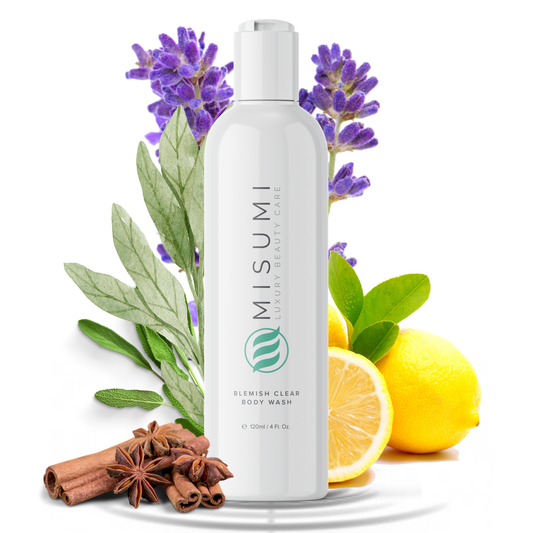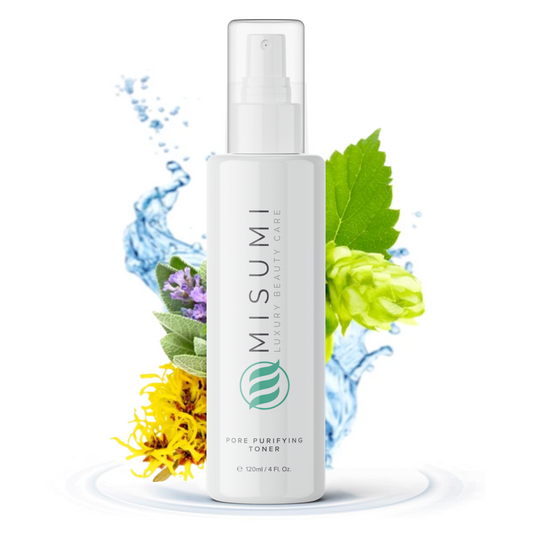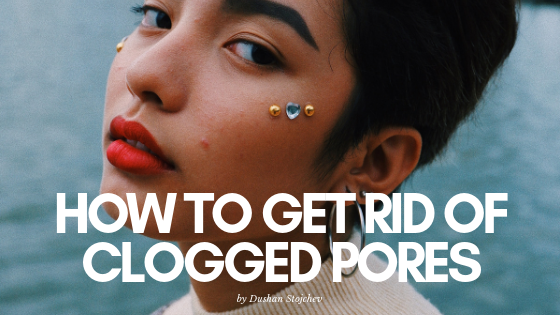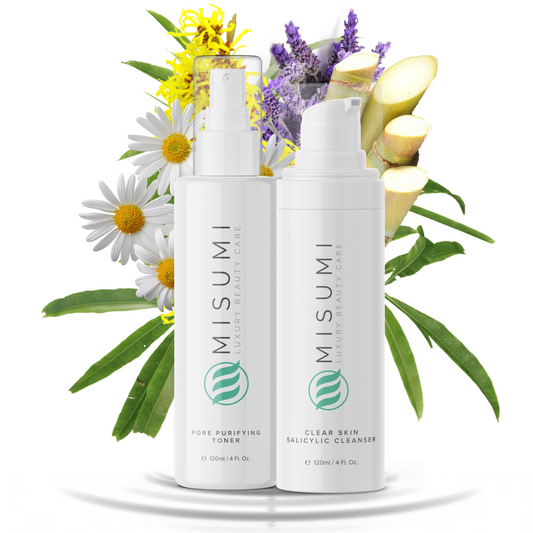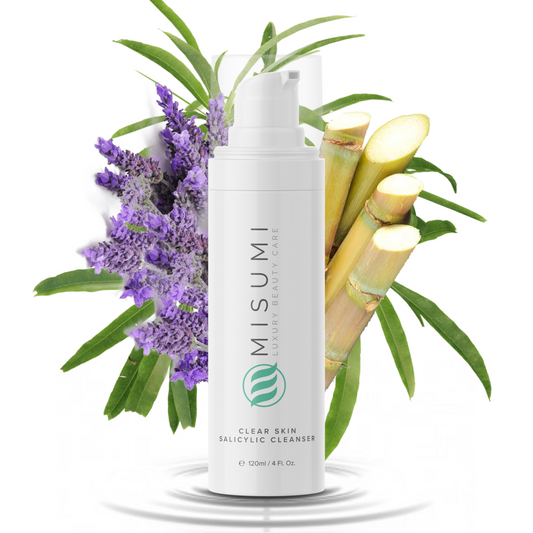In the fight against acne, acting early is often the key to getting rid of them. This doesn’t only mean prevention, but dealing with the early changes to the skin that lead to the formation of acne as well.
Before ending up with an acne inflammation, our ordinary, otherwise healthy skin goes through several changes. One such change, and perhaps the key stage when oily skin progresses into acne, is the appearance of clogged pores.
Today we’ll learn all about clogged pores, what they are, and how to deal with them.
What Are Clogged Pores?
Clogged pores are exactly what they sound like: they're pores that got clogged. However, that simple explanation can be misleading and is far from helpful when trying to prevent, or even treat, acne-prone skin. Pores become clogged thanks to a combination of factors. Most of the time, the reason cannot be reduced to just one factor or one reason.

An excess of our skin’s naturally produced oil, called sebum, causes clogged pores. However, pores can also become clogged by dead skin cells, random dust from the environment, and even the multiplication of bacteria.
As we mentioned above, our pores become clogged by a combination of any of these factors. Sometimes, your pores will be clogged by nothing else but sebum. Other times, everything can contribute to the clogging of your pores at the same time.
The medical term for a pore that's clogged is "comedo". With that in mind, comedones, or blocked pores, can belong to either two categories: open comedones, or closed comedones. Each of these kinds is a blocked pore, the only difference being whether the tip of the material clogging the pore is in open contact with the environment (an open comedone), or whether it is covered by a thin, translucent layer of epidermis (a closed comedone).
If you wear makeup, have larger pores or an excess of sebum production, you're more likely to suffer from congested pores.

Blackheads, Or Open Comedones
Open comedones are also known as blackheads. Blackheads get their name due to their appearance - they are usually brown, or very dark, and sometimes even have grey or purplish hues. They resemble a small circle, like a crater, that sits in the middle of the pore and usually widens it. Blackheads get their dark hues because the material they consist of (the skin oil, or sebum) gets into contact with the air, which contains oxygen. This contact with oxygen makes certain compounds oxidize and change their color, which makes them turn dark.
An open comedone or a blackhead is generally easier to deal with since the opening of the pore isn’t sealed by a thin surface layer of skin (called the epidermis). If you try to squeeze a blackhead, chances are you will succeed, and oftentimes with little to no complications. However, this doesn’t mean that you should, since you can spread bacteria and cause an infection if you frequently squeeze clogged pores. You may also end up with acne scars.

Whiteheads, Or Closed Comedones
Closed comedones, contrary to open comedones, do not come into contact with the air or the environment. This ensures that the material that's clogging the pore (which is usually a combination of sebum, bacteria, and pus) retains its otherwise natural, white-ish color. And as you can imagine, this feature of the closed comedones is what earns them the nickname of whiteheads. However, this can make these types of clogged pores more noticeable and prominent, which is exactly the opposite of what you need when dealing with them.
Whiteheads are also more difficult to squeeze, pop, or drain. In fact, trying to do so can cause exquisite pain at times, which is not the case with blackheads (the open types of comedones). This is because, in the case of whiteheads, the tip of the pore is sealed with a very thin, but sometimes pretty tough, layer of epidermis.
The epidermis is the uppermost layer of the skin and serves as a skin barrier. The skin barrier serves the very important function of making sure your skin is sealed and watertight, preventing any dust or particles from entering your body. Additionally, the surrounding area is usually red and sore due to all the pressure on the deeper layers of the skin.

Which is incidentally what makes squeezing whiteheads such an exercise in suffering. You probably know the intense, mind-losing pain that can sometimes ensue when you’re trying to pop a small, but stubborn whitehead. That’s because the layer of epidermis acts as a lid over the pore, shutting it tight and resisting the force you’re applying.
Basically, it’s like trying to pop a can of soda - it’s welded tight on all sides. The only way the substance that clogs your pores can go is either through the lid of the epidermis or - which makes it hurt so frigging much - into the surrounding tissue. It’s basically like stabbing yourself with your own tissues.
So, now we know what clogged pores are. But is everything that looks like a blocked pore, a blocked pore? Not really. Let’s learn what clogged pores aren’t.

What Isn’t a Clogged Pore?
There are some skin conditions that can be mistaken for clogged pores, in regards to both whiteheads and blackheads. The confusion usually happens because the skin features appear fairly similar to clogged pores. This visual similarity often leads people to mistakenly assume they have clogged their pores, when, in fact, it turns out to be something else.
The two most common skin conditions that are mistaken for clogged pores are inflamed hair follicles (also known as folliculitis) and ingrown hairs.
Folliculitis
Folliculitis is a pretty common skin condition in which a hair follicle, i.e. the skin pore holding a single hair (or sometimes two, or more hairs), becomes inflamed. The causes for this can be various, but the most common ones are persistent irritation of the affected area of the skin, fungal growth, or even a bacterial infection.

People can often mistake an inflamed hair follicle for a pimple, acne, or a clogged pore - especially a whitehead. The confusion with whiteheads is usually due to the redness that surrounds the hair follicle. However, a clogged, or inflamed hair follicle can also resemble a blackhead. In a sense, a clogged hair follicle, which also becomes inflamed, is technically a clogged pore in itself. But it’s useful to be able to tell the difference between these skin disorders, since they can lead to different things.
Inflamed follicles and ingrown hairs rarely progress into full-blown acne inflammation. Folliculitis is usually localized and doesn’t spread to other follicles. Contrary to this, if you're dealing with clogged pores, the problem is more general - more than one pore will be clogged, and it is often the case that your pores will be clogged over a wider area of the skin.
As we mentioned, confusion happens because a clogged hair follicle looks like a small, red bump on the skin at first sight. What makes it even more similar-looking to an inflamed whitehead (or even acne) is the second stage of folliculitis, when white-headed pimples form around the affected follicles. If left untreated, folliculitis can spread and mutate into crusty sores. However, that is not acne and is very different from a simple case of clogged pores.

While far from a serious skin condition, folliculitis can be intolerably itchy, slightly sore, and sometimes even embarrassing. But if left untreated, folliculitis can complicate itself, resulting in severe infections of the hair follicles that can cause permanent scarring and permanent hair loss.
Ingrown Hairs
A less intense, but no less unpleasant form of hair follicle trouble is the infamous ingrown hair. Ingrown hairs, while less dangerous than folliculitis, often look very similar to a pimple or a clogged, inflamed pore. This usually happens as a consequence of friction, with one of the most common causes being tight pants.
When a hair becomes ingrown, it bends back on itself and gets stuck in its own follicle. Ingrown hairs are - technically - blocked pores. The difference is in the material that clogs the pore, which is the hair itself. As you can imagine, the hair clogs up the follicle pretty well, closing it tightly shut. This eventually leads to the pore becoming swollen from all the sebum, bacteria, and dead skin cells inside it.

If you’re really not sure whether the problem you're facing is folliculitis, ingrown hair, or a case of clogged pores, you shouldn’t rush. It’s very important to make sure that you have the right diagnosis before treating yourself. A trip to the doctor or dermatologist can save you not just a lot of money, but a lot of nerves, health complications, and time.
Now that we’ve seen what blocked pores are, what they aren’t, and how they come into being, let’s take a look at the treatments for them. Here are the best ways to get rid of them.
How to Get Rid of Clogged Pores
We mentioned above that pores can become clogged due to a variety of factors and materials. Sometimes, it’s a bacterial infection. Other times, it’s overactive sebaceous glands that pump out too much sebum in the pore.
But dead skin cells and random, microscopic dust or dirt from the environment can clog our pores too. Touching our faces with unclean hands is a huge factor in transferring microscopic material on our faces, which contributes to clogged pores.
All right, so how to deal with all that? Here are some of the best methods to prevent clogging your pores.

Use Pore Strips to Unclog Your Pores
Pore strips are made of paper or other materials and usually come in different sizes.
What makes them so effective at unclogging pores is their adhesive layer. Once applied to the skin (adhesive side down, of course) the strips attach themselves to the tips of the clogged pores. The adhesive binds to the material clogging the pore, and when the pore strip is removed, it pulls out the gunk that clogged the pores with it as well.
Bear in mind though, that these strips are most effective when dealing with blackheads, or open comedones. This is because the tips of the blackheads are exposed and in direct contact with the air and the environment. But, that means that they are also able to come into contact with the adhesive material on the pore strip. Once attached, the glue on the pore strip will pull out the material from the blackheads, returning them to normal, unclogged pores. In the case of whiteheads, pore strips don’t work so well.

You can use them to remove a whole variety of material from your skin too, not just unclog pores. They can also remove:
- Bacteria
- Skin oil (sebum)
- Dead skin cells
- Hair
- Dust
- Anything else stuck on the skin
You can buy pore strips over the counter in any well-equipped cosmetics shop. Of course, every product varies, so whatever you buy, always follow the instructions. Generally, that will include making your skin wet before applying them.
Are these strips harmful or dangerous? Not if you use them well. You'll probably feel a pinch after you pull out a particularly strong hair and that’s it. However, if your skin is sensitive or you suffer from skin allergies, maybe avoid using this product, since they can cause irritation.

Get Rid of Clogged Pores With the Help of a Charcoal Mask
Activated charcoal is one very trendy skincare ingredient at the moment. But here’s the thing - it’s well-deserved. Activated charcoal is found in shampoos, shower gels, even toothpaste, scrubs, pore cleansers, masks… Because it actually works.
But speaking specifically in the context of skincare, activated charcoal has particular properties. It offers benefits like cleaning pollution, toxins, and random dirt from your pores. While research is still lagging behind, most people seem satisfied and report positive results from using activated charcoal in their skincare routines.

Depending on the specific product in question, instructions for its use will vary. Is it a face mask? Or maybe a facial cleanser or face wash? At any rate, most products will want you to wash and clean your face before use. Additionally, some masks will need to be washed off of your face, but others will need to be peeled away.
Making your own activated charcoal mask isn’t the smartest thing. Dermatologists and beauty experts have warned following the popular DIY charcoal face mask trend. The problem is that using glue in combination with charcoal powder can damage, or at least irritate, your skin. For the best results, always use professional and tested activated charcoal masks, or alternatively, try other home-made clay masks that perform much the same function and more.
You can find safe, and effective activated charcoal face masks in your local beauty store. If you have sensitive skin, consult with your dermatologist before using any face masks. They will be able to tell you which ingredients to avoid, and which will be suitable for your skin type.

Skin Extraction Can Help You Unclog Your Pores
It kind of sounds scary, doesn’t it? But rest easy, because it's a safe procedure. Performed by dermatologists and skincare specialists, skin extractions are usually performed along with other facial treatments, with a thin, metallic tool known as a skin extractor.
The tool resembles a spoon with a tiny loop at the end of its handle. This loop is then pressed over the clogged pores. The circular, uniform pressure of this tiny metallic loop makes the surrounding skin squeeze out the gunk.
Occasionally, skin extraction can be done on pimples and acne too, if the dermatologist determines they are safe to be “squeezed” like that.
Of course, this can be somewhat painful and unpleasant. Limited bleeding can occur, and some minor wounding as well. That is why dermatologists clean your skin before and after performing skin extraction, by applying antiseptic and antibacterial substances over the affected area. Additionally, they may offer soothing creams, masks, or other treatments as well.
All of this works best when done by actual professionals. You should really reconsider using a skin extractor in the privacy of your home since you can easily give yourself an infection.

Exfoliation Can Get Rid Of Clogged Pores
Exfoliation is not primarily used to unclog pores, but it’s a very efficient procedure when it comes to cleaning the skin's surface. It can remove dead skin cells, excess oil, environmental debris, and more. It also encourages encourage cell turnover. As you can imagine, that effectively works wonders in preventing congested skin - especially if you have large pores.
However, not all methods for exfoliation are equal. Generally, exfoliation can be divided into chemical exfoliation and mechanical (or physical) exfoliation. Some of the best substances used for chemical exfoliation include salicylic acid (BHA), glycolic acid and lactic acid (AHAs), and other so-called acids. Chemical exfoliators are known to be milder and safer for the skin in comparison to Physical exfoliators. However, you should be very careful with applying chemical exfoliants, and especially if you have sensitive skin, since they can cause irritation or even burns.

Mechanical exfoliation includes various scrubs, cleansing cloths, exfoliating brushes, gels, and so on. Most mechanical exfoliators contain small granules and require you to massage or rub your skin. Besides risking irritation and even injuring your skin, these small granules can even clog your pores.
In any case, it’s always better to be safe than sorry when it comes to using new products. To check how your skin will react to a certain skincare product, home remedy, or any other substance perform a patch test first. Patch tests are super simple to do, and can help you avoid injuries and waste money on products that aren’t good for you. If you have any doubts about using any sort of exfoliation, consult with your doctor or dermatologist too.

Steam Can Unclog Your Pores
Another method you can use to get rid of clogged pores is steaming. As with exfoliation, steaming isn’t used exclusively for getting rid of clogged pores. Steam can have many beneficial effects on our skin. It can cleanse it, but the heat will also relax it, which helps the pores become wider and clean themselves. It'll help remove dead skin cells, excess oil, and other dirt.
Steaming isn’t used on its own when the goal is to unclog pores, but in tandem with other methods. Most often, steaming is used as a preparatory phase for using a skin extractor. By ensuring the skin is relaxed, soft, and the pores open, the skin extractor is a lot more efficient. This, as you can guess, leads to better overall results.
You can steam your face at home, or you can purchase a steaming kit over the counter in any well-supplied cosmetics store. Alternatively, you can visit a beautician, a cosmetician, or a dermatologist and have it performed professionally.

What To Avoid If You Have Clogged Pores
In this day and age, you'll find hundreds, and even thousands of DIY solutions, and home remedies for getting rid of blocked pores. But do they all work? Of course not. Some can even be harmful.
For example, you should avoid making and using your own scrub based on baking soda. Although many people recommend this home remedy, baking soda is highly alkaline, and it can mess up your skin’s pH level, or even lead to dry skin, resulting in the over-production of your natural oils. If you need to unclog your pores, there are other, better, and safer treatment options for it other than baking soda.
Additionally, avoid using lemon or fresh lemon juice. While fresh lemon juice can act as a natural bleach, it is also highly acidic and can irritate or damage your skin. This is especially important for people with sensitive skin, who will almost surely experience negative reactions when applying fresh lemon juice.

How to Prevent Clogged Pores
But what about preventing them? Well, that problem is a lot simpler.
As we mentioned in the sections above, our pores become clogged from sebum, dirt, dust, and other microscopic filth getting stuck to our faces. This means that keeping our faces clean is one of the best ways to prevent the onset of clogged pores.
Following a daily skincare routine can also help a lot. However, some skincare products contain pore-clogging ingredients, especially if they’re oil-based. If you have an oily skin type, always use skincare oil-free products that are labeled as “non-comedogenic.” Avoid things like coconut oil. Too much oil will block enlarged pores.
Also, avoid products that will dry out your skin, as this can cause even more oil production and clog pores.
Try Misumi's AHA 10% Skin Perfecting Cleanser to prevent breakouts and reduce skin concerns. This pore cleanser removes makeup, impurities, dead cells, and excess oil.
Furthermore, exfoliation also helps. When it comes to that, avoid exfoliating your face too frequently, since the skin needs to recover. Dermatologists suggest that once a week is enough to achieve healthy, clear skin.
Finally, avoid touching your face. It may seem simple, but it may be behind that sudden outburst of acne and is a crucial tip if you want to avoid complicating your skin’s health.

Summing It Up
Our pores perform a number of crucial functions for our health. They help our skin to breathe, but they also keep it watertight, protecting our body from microscopic intruders. However, poor hygiene, hormonal imbalances, or bacterial infection can cause our pores to become clogged. And with that, inflamed.
There are many ways to unclog pores. From exfoliation to skin extraction, and even steaming or prescription medications, there's a broad selection of methods.
Personal hygiene is the best way to prevent the clogging of pores. Besides washing and cleaning your face, adopting a cleansing skincare routine on a daily basis can also help. However, you should only use skincare products that are “non-comedogenic”, since other types of products can clog your pores. And remember - don’t touch your face!
References
Why you shouldn’t use those black peel-off face masks
Oily Skin: A review of Treatment Options
Skin care for acne-prone skin
This information is meant to supplement, not replace advice from your doctor or healthcare provider and is not meant to cover all possible uses, precautions, interactions or adverse effects. This information may not fit your specific health circumstances, and its goal is to offer a general view of the subject. In case you are suffering from a severe case of acne, you should consult with a dermatologist or a certified medical professional.
